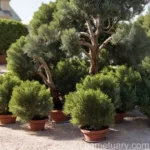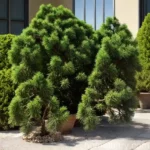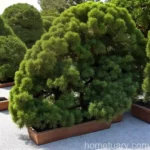The Ultimate Guide to Creeping Juniper (Juniperus horizontalis ‘Glomerata’)
In the world of landscaping and gardening, the creeping juniper, scientifically known as Juniperus horizontalis ‘Glomerata’, holds a special place. This versatile evergreen plant is prized for its hardiness, low maintenance requirements, and striking appearance. Whether you’re aiming to create an eye-catching ground cover, prevent soil erosion, or add visual interest to your garden, the creeping juniper is an exceptional choice. In this comprehensive guide, we will explore everything you need to know about this remarkable plant, from its cultural requirements to its uses, common diseases, and more.
What is Creeping Juniper (Juniperus horizontalis ‘Glomerata’)?
The creeping juniper, also known by its botanical name Juniperus horizontalis ‘Glomerata’, is a low-growing evergreen shrub with a spreading, creeping habit. This plant belongs to the cypress family, Cupressaceae, and is native to North America. The ‘Glomerata’ variety features dense, scale-like blue-green foliage that provides year-round interest, making it a popular choice for landscapes and gardens.
Key Takeaways:
Before delving into the specifics of creeping juniper care and maintenance, it’s essential to highlight the key takeaways associated with this versatile plant.
- The creeping juniper (Juniperus horizontalis ‘Glomerata’) is prized for its low-growing, spreading habit, making it an ideal choice for ground cover or slope stabilization.
- This plant is known for its adaptability to various soil types and its ability to thrive in challenging conditions, including poor, rocky, or sandy soils.
- Creeping juniper requires minimal maintenance, making it an excellent option for low-maintenance landscapes and gardens.
- It is crucial to provide well-drained soil and ample sunlight to ensure the health and vigor of creeping juniper plants.
- This evergreen shrub is valued for its exceptional disease resistance and ability to withstand harsh environmental conditions.
Now that we’ve outlined the key takeaways, let’s explore the cultural requirements, uses, and maintenance practices associated with creeping juniper in detail.
Culture
Water
Creeping juniper is known for its drought tolerance once established. However, it is crucial to provide regular watering during the plant’s initial establishment phase to promote healthy root development. After the first year, the plant generally thrives in drier conditions and does not require frequent watering. When watering, it’s important to ensure that the soil is well-drained to prevent waterlogging, which can lead to root rot.
Sunlight
Proper sunlight is essential for the health and vigor of creeping juniper plants. These shrubs thrive in full sun to partial shade, with a preference for at least six hours of direct sunlight daily. Insufficient sunlight can lead to poor growth and reduced foliage density. Therefore, when selecting a planting location, prioritize areas that receive ample sunlight for optimal results.
Soil
The creeping juniper is highly adaptable to various soil types, including sandy, loamy, or rocky soils. It thrives in well-drained soils and is tolerant of poor soil conditions. It is essential to avoid waterlogged or compacted soils, as they can negatively impact the plant’s health. Prioritize soil preparation by ensuring adequate drainage to promote healthy growth and minimize the risk of root diseases.
Fertilizer
One of the remarkable attributes of creeping juniper is its minimal fertilizer requirements. In most cases, these plants thrive without the need for regular fertilization. However, if the soil quality is poor or the plant’s growth appears stunted, applying a balanced, slow-release fertilizer in early spring can provide a beneficial nutrient boost. Always follow the recommended application rates and avoid excessive fertilization, which can harm the plant.
Uses
Ground Cover
One of the primary uses of creeping juniper in landscaping is as a ground cover. Due to its low-growing, spreading habit and dense foliage, it creates a lush carpet-like effect that adds visual appeal to garden beds, slopes, and embankments. Its ability to effectively suppress weeds and erosion makes it a popular choice for ground cover applications.
Slope Stabilization
Creeping juniper’s extensive root system and spreading growth habit make it well-suited for stabilizing slopes and preventing soil erosion. When planted on slopes, its roots help anchor the soil, minimizing the risk of erosion caused by water runoff or environmental factors. This makes it an excellent choice for landscaping projects that involve hilly or sloped terrain.
Border Plant
In addition to its role as a ground cover, creeping juniper serves as an attractive border plant, delineating garden beds, pathways, and other landscape features. Its low, mounding growth habit creates a natural border that adds definition and structure to the garden, enhancing its overall visual appeal.
Landscaping Accent
Beyond its practical uses, creeping juniper is valued as a landscaping accent due to its year-round visual interest. The vibrant blue-green foliage provides a striking contrast to other plants, and its low maintenance requirements make it an attractive option for enhancing the aesthetic appeal of residential and commercial landscapes.
Pruning
Pruning Overview
Proper pruning is essential for maintaining the health and appearance of creeping juniper plants. While these shrubs have a naturally dense, compact growth habit, occasional pruning helps control their size, shape, and density. Additionally, pruning can promote air circulation and sunlight penetration, which contributes to overall plant health.
Pruning Techniques
When pruning creeping juniper, it’s crucial to use sharp, clean pruning shears to make precise cuts without causing unnecessary damage to the plant. The following are key pruning techniques to consider:
- Thinning: Periodic thinning of the plant’s foliage helps maintain an open, airy structure and prevents the interior from becoming dense and prone to disease.
- Shaping: To maintain a neat, uniform appearance, lightly trim the outermost growth to shape the shrub and encourage a tidy, compact form.
- Broken or Dead Branch Removal: Regularly inspect the plant for broken or dead branches and promptly remove them to enhance the plant’s overall health and appearance.
Pruning Frequency
Creeping juniper generally requires minimal pruning, with annual or biennial maintenance being sufficient for most plants. Pruning is commonly performed in early spring or late winter before the start of the growing season. It’s important to avoid heavy pruning, as it can stress the plant and lead to reduced growth and vitality.
Propagation
Propagation Methods
Creeping juniper can be propagated through several methods, including:
- Stem Cuttings: Taking stem cuttings from existing plants and rooting them in a suitable growing medium is a common method of propagating creeping juniper. Softwood cuttings taken in early summer tend to root successfully and develop into new plants.
- Layering: Another propagation technique involves layering, where a low-growing stem is encouraged to make contact with the soil, allowing it to develop roots. Once the roots are established, the stem can be separated to create a new individual plant.
- Division: Mature creeping juniper plants can be divided by carefully separating the root ball into smaller sections, each with its set of roots. This method is best performed during the plant’s dormant season.
Propagation Considerations
When propagating creeping juniper, it’s important to provide a suitable rooting environment, consistent moisture, and adequate protection from extreme temperatures. Additionally, selecting healthy, disease-free plant material for propagation helps ensure the success and vigor of the new plants.
Container Popularity
Creeping Juniper in Containers
While creeping juniper is commonly utilized as a ground cover and landscaping feature, it also thrives in container gardens. Planting creeping juniper in containers allows for greater flexibility in placement, making it an excellent choice for patios, balconies, and other outdoor spaces. Its trailing, cascading growth habit adds visual interest to container gardens, and its low maintenance requirements make it ideal for urban and small-space gardening.
Container Selection
When choosing containers for creeping juniper, prioritize options that provide adequate drainage to prevent waterlogging, as excessive moisture can harm the plants. Additionally, select containers that are proportionate to the plant’s growth habit, providing ample space for root development and expansion. Lightweight, durable containers made of materials such as concrete, fiberglass, or resin are well-suited for growing creeping juniper in a container environment.
Container Care
Proper container care is vital for the health and longevity of creeping juniper plants. Ensure that the containers receive sufficient sunlight, as these plants thrive in full sun to partial shade. Regular watering is essential, but it’s crucial to allow the soil to dry out slightly between waterings to prevent root rot. Additionally, monitor the plant for signs of overcrowding and consider repotting as needed to promote healthy growth.
Common Diseases
Disease Resistance
Creeping juniper, including the ‘Glomerata’ variety, is known for its exceptional disease resistance, making it a low-maintenance and reliable plant for various environments. These shrubs are generally resistant to most common fungal diseases and exhibit strong overall vigor when provided with suitable growing conditions. However, it’s important to monitor plants for signs of stress, as weakened plants may become more susceptible to disease.
Disease Diagnosis
Although creeping juniper is highly disease-resistant, it’s essential to be aware of potential disease symptoms to address any issues promptly. Common signs of disease in creeping juniper include:
- Needle Browning: Yellowing or browning of the foliage, particularly at the tips or along the branches.
- Twig Dieback: Sections of the plant experiencing dieback, where the branches or twigs turn brown and become brittle.
- Fungal Growth: Presence of unusual fungal growth, including powdery mildew or rust-like formations on the foliage.
- Stunted Growth: A noticeable reduction in the plant’s growth rate and overall vigor, which may indicate underlying health issues.
If any of these symptoms are observed, it’s essential to investigate the cause promptly and take appropriate measures to address the issue. Proper cultural practices, such as providing well-drained soil, adequate sunlight, and proper spacing, can significantly reduce the risk of disease development in creeping juniper plants.
Common Pests
Pest Resistance
Creeping juniper, including the ‘Glomerata’ variety, boasts natural resistance to many common pests, thanks to the aromatic nature of its foliage and its overall hardiness. While these plants are generally pest-resistant, periodic inspection is vital to detect and manage any potential pest infestations promptly. Additionally, promoting overall plant health through proper cultural care practices helps bolster their natural pest resistance.
Pest Monitoring
Regular monitoring of creeping juniper plants is important for early pest detection. Common pests that may affect these shrubs include spider mites, bagworms, and certain scale insects. Symptoms such as discoloration, leaf stippling, and webbing on the foliage may indicate the presence of pests, signaling the need for immediate intervention.
Integrated Pest Management (IPM)
Integrated Pest Management (IPM) strategies, which emphasize proactive prevention and targeted pest control, are effective in managing potential pest issues in creeping juniper. Beneficial insects, natural predators, and cultural practices, such as proper pruning and sanitation, should be prioritized to maintain a healthy balance and minimize the need for chemical intervention.
Botanist’s Tips
Creeping Juniper Care Tips
- Soil Preparation: Prior to planting, ensure the soil is well-drained and free from compaction to promote healthy root development.
- Sunlight Requirements: Provide ample sunlight, with at least six hours of direct sunlight daily to support optimal growth and foliage density.
- Watering Practices: During the establishment phase, provide regular watering, and transition to a more drought-tolerant approach once the plant is established.
- Pruning Guidelines: Practice minimal, selective pruning to maintain the plant’s structure and promote air circulation, aiming to avoid excessive pruning that can stress the plant.
- Disease Prevention: Monitor the plant for signs of stress or disease and address any issues promptly through proper cultural practices and targeted intervention when necessary.
Fun Facts
- The creeping juniper (Juniperus horizontalis ‘Glomerata’) is a key ingredient in the production of gin, thanks to the flavorful juniper berries it produces.
- In traditional medicine, juniper has been used for its purported medicinal properties, including as a diuretic and to treat various ailments.
- Some species of juniper, including creeping juniper, are associated with folklore and symbolism, often representing concepts such as protection and purification in various cultures.
Links to External Resources
For further information and detailed insights into creeping juniper (Juniperus horizontalis ‘Glomerata’), consider exploring the following resources:
- Royal Horticultural Society – Juniperus horizontalis ‘Glomerata’
- University of Maryland Extension – Creeping Juniper
- Missouri Botanical Garden – Juniperus horizontalis ‘Glomerata’
- University of Florida IFAS Extension – Creeping Juniper for Florida Landscapes
- The Spruce – Growing Creeping Juniper
In conclusion, the creeping juniper (Juniperus horizontalis ‘Glomerata’) is a remarkable plant valued for its versatility, low maintenance requirements, and aesthetic appeal. Whether used as a ground cover, slope stabilizer, or landscaping accent, this evergreen shrub brings enduring beauty to a wide range of garden settings. By understanding its cultural needs, maintenance practices, and potential uses, gardeners can leverage the unique qualities of creeping juniper to elevate their outdoor spaces and create stunning, resilient landscapes.
Plant enthusiasts and landscaping professionals alike can benefit from the enduring charm and practical benefits of the creeping juniper, making it a worthy addition to diverse garden environments. With its remarkable disease resistance, adaptability to various soil types, and striking visual impact, the creeping juniper stands as a testament to the enduring allure of evergreen plants in the world of horticulture.















